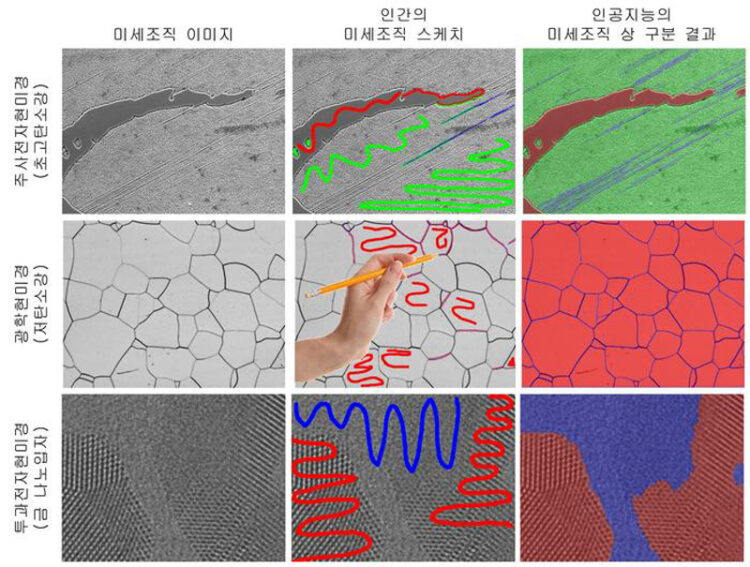Easier and faster materials microstructure analysis through human-AI collaboration!

Microstructure segmentation based on human-AI collaboration
Credit: Korea Institute of Materials Science (KIMS)
KIMS-POSTECH joint research team develops a unified microstructure segmentation approach.
The research team led by Dr. Se-Jong Kim and Dr. Juwon Na of the Materials Data Management Center in the Materials Digital Platform Division together with the research team led by Professor Seungchul Lee of POSTECH has developed a technology that can automatically identify and quantify materials microstructure from microscopic images through human-in-the-loop machine learning. KIMS is a government-funded research institute under the Ministry of Science and ICT.
Microscopic imaging systems visualize material structure information at multiple levels, from the nanoscale to the mesoscale. Quantitative analysis of microstructure is the process of extracting structural statistics from microscopic images. However, due to the complexity and diversity of microstructure, there have been many limitations for humans or AI to perform this alone.
By effectively integrating human and AI capabilities, the research team has developed an integrated framework for quantitative microstructure analysis. This technology enables the AI to perform microstructure segmentation using only a single microstructure image and its corresponding scribble annotation by domain experts. In addition, the AI interacts with humans by actively requesting scribble annotation from experts in order to bring additional improvements in both the model’s performance and reliability. Through extensive experiments, the research team confirmed that the framework of human-AI collaboration is universal and can be applied to a wide range of materials, microstructures, and microscopic imaging systems.
While previous research has required the collection of large amounts of dense annotation, this study has greatly reduced annotation costs by replacing dense annotation with scribble annotation that can be easily drawn using a pen or mouse. This technology will be incorporated into the Automated Microstructure Quantitative Analysis System (TIMs) being developed by KIMS. This will make it easy for general researchers to use.
Dr. Juwon Na, a senior researcher at KIMS, said, “This study is the result of improving the existing subjective and time-consuming quantitative analysis of microstructure into an objective and automated process,” and Professor Seungchul Lee of POSTECH, added:“Our framework that interacts with experts is expected to be widely used as a core analysis technology in industry and research, and through this, we expect to dramatically reduce the cost and time of new materials research and development and further significantly improve reliability.”
This research was supported by the Ministry of Science and ICT through the basic project of the Korea Institute of Materials Science, the mid-career researcher support project of the National Research Foundation of Korea, and the Alchemist project of the Ministry of Trade, Industry and Energy. The research results were published on 15 August in Acta Materialia (first author: Dr. Juwon Na), the most authoritative journal in the field of metallic materials.
About Korea Institute of Materials Science(KIMS)
KIMS is a non-profit government-funded research institute under the Ministry of Science and ICT of the Republic of Korea. As the only institute specializing in comprehensive materials technologies in Korea, KIMS has contributed to Korean industry by carrying out a wide range of activities related to materials science including R&D, inspection, testing&evaluation, and technology support.
Journal: Acta Materialia
DOI: 10.1016/j.actamat.2023.119086
Article Title: A unified microstructure segmentation approach via human-in-the-loop machine learning
Article Publication Date: 15-Aug-2023
All latest news from the category: Materials Sciences
Materials management deals with the research, development, manufacturing and processing of raw and industrial materials. Key aspects here are biological and medical issues, which play an increasingly important role in this field.
innovations-report offers in-depth articles related to the development and application of materials and the structure and properties of new materials.
Newest articles

Largest magnetic anisotropy of a molecule measured at BESSY II
At the Berlin synchrotron radiation source BESSY II, the largest magnetic anisotropy of a single molecule ever measured experimentally has been determined. The larger this anisotropy is, the better a…

Breaking boundaries: Researchers isolate quantum coherence in classical light systems
LSU quantum researchers uncover hidden quantum behaviors within classical light, which could make quantum technologies robust. Understanding the boundary between classical and quantum physics has long been a central question…

MRI-first strategy for prostate cancer detection proves to be safe
Active monitoring is a sufficiently safe option when prostate MRI findings are negative. There are several strategies for the early detection of prostate cancer. The first step is often a…



